


































































■ WHAT ARE YOUR CUSTOMERS REALLY THINKING? ■ BENEFICIAL OWNERSHIP INFO FILING DEADLINE







































Automation technology is allowing cleaners to serve their customers in ways never before imagined, but striking the balance between convenience and the human touch can be tricky.
Successful cleaners make sure they understand what their customers are experiencing from the other side of the front counter. We examine ways to gather this feedback and, then, how to put it into action.










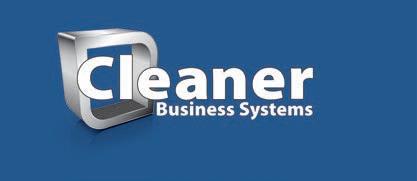
For more than a decade, American Drycleaner has published 11 times a year, with a combination issue for November and December (just as we’re doing this month). As many industry experts have said in the pages of this magazine over the years, however, just because that’s the way we’ve always done it doesn’t mean that’s how we should continue.
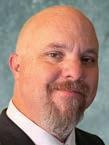
Dave Davis
Taking into account the holiday and end-of-year schedules of our sources, advertisers and others, we’ve realized it makes more sense to publish a December issue on its own and combine the January and February issues of the magazine instead. And, because there’s no time like the present, that’s what we’re doing now. This is the last print issue we’ll be running until February 2025 — after that, we’ll be back every month in the coming year.
In the meantime, we’ll still be publishing new material regularly on our website (www.americandrycleaner.com), so come and see what we have to offer there!
For the features of this issue of American Drycleaner, just as we’re doing with our print schedule, we’re looking into the future while taking stock of present conditions.
Our first feature, “Automation vs. Customer Service,” examines some of the new technology that dry cleaners are using today to provide customers more options while easing the demands of the challenging labor market. While some customers might be reluctant to forgo human interactions with a drycleaning business, others are happy to take advantage of the added convenience. We examine how cleaners can best strike a happy balance.
Our second feature, “What Are Your Customers Really Thinking?” examines some of the ways successful cleaners are getting feedback from their clients and putting this valuable information to work in their company. Stepping out from behind the front counter can highlight issues that might otherwise go unnoticed.
So, we’ll see you again (in print) in February, but remember we’re still just an internet click away!
American Drycleaner (ISSN 0002-8258) is published monthly except Nov/Dec combined. Subscription prices, payment in advance: U.S., 1 year $50.00; 2 years $100.00. Single copies $10.00 for U.S. Published by American Trade Magazines LLC, 650 West Lake Street, Suite 320, Chicago, IL 60661. Periodicals postage paid at Chicago, IL and at additional mailing offices.
POSTMASTER, Send changes of address and form 3579 to American Drycleaner, Subscription Dept., PO Box 23, Forest Park, IL 60130. Volume 91, number 8. Editorial, executive and advertising offices are at 650 West Lake Street, Suite 320, Chicago, IL 60661. Charles Thompson, President and Publisher. American Drycleaner is distributed selectively to: qualified dry cleaning plants and distributors in the United States. The publisher reserves the right to reject any advertising for any reason. © Copyright AMERICAN TRADE MAGAZINES LLC, 2024. Printed in U.S.A. No part of this publication may be transmitted or reproduced in any form, electronic or mechanical, without written permission from the publisher or his representative. American Drycleaner does not endorse, recommend or guarantee any article, product, service or information found within. Opinions expressed are those of the writers and do not necessarily reflect the views of American Drycleaner or its staff. While precautions have been taken to ensure the accuracy of the magazine’s contents at time of publication, neither the editors, publishers nor its agents can accept responsibility for damages or injury which may arise therefrom.
Publisher
Charles Thompson
312-361-1680
cthompson@ATMags.com
Editorial Director
Bruce Beggs
312-361-1683
bbeggs@ATMags.com
Editor
Dave Davis
312-361-1685
ddavis@ATMags.com
Digital Media Director
Nathan Frerichs
312-361-1681
nfrerichs@ATMags.com
Production Manager
Mathew Pawlak
Advisory Board
Jan Barlow
Kermit Engh
John-Claude Hallak
Monika Manter
Wesley Nelson
Kyle Nesbit
Fred Schwarzmann
Vic Williams
Wayne Wudyka
National Sales Manager
Linda Lee
218-310-6838
312-361-1682
Linda@ATMags.com
Office Information
Main: 312-361-1700
Subscriptions 847-504-8175

amd@omeda.com


www.american drycleaner.com


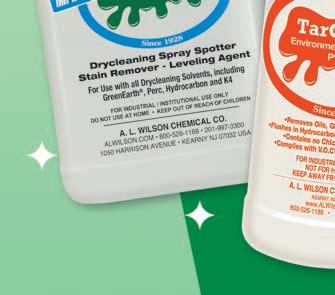





















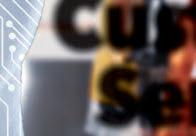





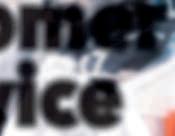







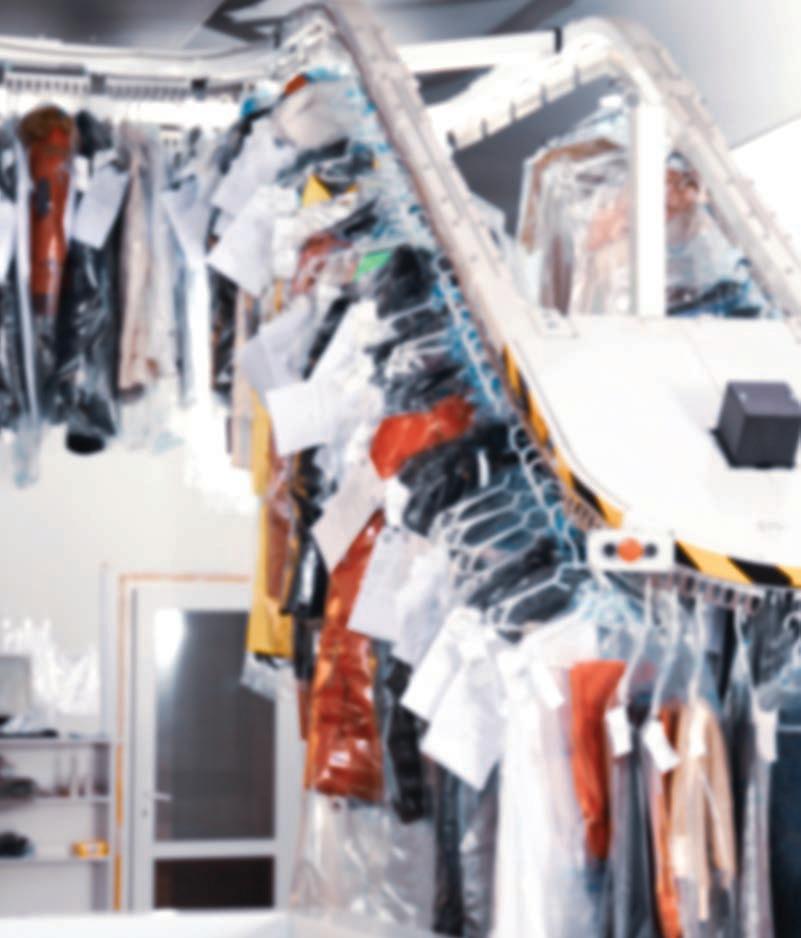



By Dave Davis, Editor

In a personal services industry like dry cleaning, the human touch is a foundation of doing business. But as technology improves and customers increasingly want more flexible hours and experiences, automated processes are starting to make inroads in ways not considered just a few years ago.


Automated kiosks, lockers, apps, notifications and more are changing the way cleaners do business. But how can cleaners balance the convenience and other benefits of automated service with getting to know their customers on a personal level?
For Gary Maloney, president and owner of Nu-Yale Cleaners, headquartered in Jeffersonville, Indiana, and serving the Louisville metro area, the pandemic opened his eyes to see what automation had to offer.
“We put in some lockers just because of the weird world,” he says, “and after that, we added some kiosks.”
Nu-Yale now has five kiosk locations in its 14-store operation.
“Those each have a mag lock we put on the door that opens at 5 a.m. and locks at 10 p.m.,” he says. “In the time between, you can come in and drop off and pick up. We staff it from about 10 a.m. to 6 p.m. So, we can have just one person there to mark the clothes while having a presence when a customer wants to come in.”
tion — more than 75% of the company’s business comes from its extensive route service — and was surprised by the customer reception.
“We’ve had some people actually go off the route service and prefer to use the kiosk,” she says, “so that’s been a nice balance.”
While Fox’s kiosk system has been installed for about a year, she’s embraced other automated systems.
“We have a mobile app that we’ve used for about four years, which is really helpful for our customers to track their orders and get notifications,” she says. “We’ve also automated all of our text and email updates on their pickup, delivery and order status.”
Cleaners who don’t want to see their service looked at as a commodity — where customers take their business to the lowest-priced cleaner — understand that building a relationship with the customer is key. When it comes to automation, finding that balance between personalization and faceless-but-easy accessibility can be tricky.


Andrew Rivkin, owner of Embassy Cleaners in Westchester County, New York, has three locations, along with routes that make 900 stops daily. He’s added a kiosk system in the lobby at his Scarsdale location.
“That area is a very upscale market where there is a desire to have that personalized touch,” he says. “So, in this location, we also have a front counter that is attended Monday through Friday, 9 a.m. to 6 p.m., and Saturdays, 9 a.m. to 5 p.m., so there’s ample opportunity for our customers to receive that personalized service with faceto-face interaction with one of our CSRs.”
Maggie Fox, owner of Fox Cleaners in Tulsa, Oklahoma, put a kiosk system in the company’s sole loca-
“Metalprogetti, who manufactured our system, was strongly recommending that we go 100% automated at this location,” Rivkin says, “and I was seriously considering it, because there are certainly some benefits to having a totally automated location without having to incur the cost of staff operating this process.”
Keeping that crucial balance in mind, however, made him reconsider.
“I ultimately decided to also put in the tended front counter in order to be available for our clients and maintain the personal touch. We have a discerning clientele with high expectations, and we provide a high level of personal service, which our pricing reflects. So, I felt it was important to have staff available on-site to personally meet with our clients, if that is the type of interaction they prefer.”

“Initially, we were concerned about losing that human touch,” Fox says, “but we took every effort we could to ensure that the automation that we brought in was complementing, rather than replacing, the human interaction.
“The kiosks and lockers make all our transactions really easy and simple, but our staff is still available during our business hours to address any questions, give advice and assist with more personalized service. So, we think that blend really allows the customers to enjoy the efficiency, but not sacrifice that human connection, which is who they know us to be about.”

Advancements in technology, Maloney says, have made this type of system much more attractive than it was just a few years ago.
“We put in a kiosk about 10 years ago and we had






























a small percent of people who used it — they liked the hours,” he says. “That system just wasn’t ready for prime time, though. Today, anybody can walk up and sign up as a new customer — you don’t have to put your credit card on file — so it’s basically accessible to anybody. Ten years ago, that wasn’t true, and it wasn’t that great of a success. The technology has improved, and people have gotten more used to using things like this.”
No matter how advanced an automated system is, it won’t matter if customers are apprehensive about using it. By educating them, however, the acceptance level can go up quickly.

“We trained our team to be super-focused on providing more personalized service,” Fox says. “So, when our customers came to the front counter, we would let them know that the kiosk was now a service that we offer and see if they would like to be introduced to it. Once we took them out there and showed them how to use it and how simple it was, they kind of took it and ran with it. New technology is scary for people, but I think once they’re familiar with it, it becomes very user-friendly.”
minutes to complete a transaction. Now, it’s probably a minute or less. They come in, use it and they’re gone.”
Rivkin knows, however, that not all customers are going to be ready — or willing — to use an automated system, no matter how easy it is to operate.
“There are certainly customers who are not comfortable with the technology, or just prefer to conduct these transactions with the human being,” he says. “And the way that we address that is we accept the fact that some customers don’t want to use our automated systems, and we have no problem at all with this. We are happy to provide both automated as well as fully attended systems in order to work with our customers’ preferences and provide them with what they want.”
One of the benefits for both cleaner and customer when it comes to automation is being able to free up staff to better serve the client.

Maloney also focused on ensuring that staff would train customers who wanted to use the new system, walking them through the process if they so desired.
“It’s getting now that they need very little help,” he says. “We get a report from Metalprogetti, and when we first put it in, it was taking customers about two or three

“The automation allows our staff to spend more time with the customer who happens to be at the counter in front of them,” Rivkin says, “without the CSR feeling the pressure of a long line. Additionally, the automation allows our staff to provide better communication in a reliable and more timely manner.”
“Our CSRs don’t have to spend as much time waiting on people at the counter,” Fox agrees. “For instance, with the kiosks handling those basic transactions, they can dedicate more attention to our customer requests, care, consultations and resolving any issues that arise. And I think that creates a much higher quality and more personalized experience for each customer, and that’s key.”
These systems can also help customers protect their most precious commodity: time.
“If there’s a line at our front counter when a customer






































comes in, our kiosk customers appreciate that they can literally skip the line without having to wait for their turn,” Rivkin says. “With the kiosk, it literally takes around one minute to drop off your cleaning and one minute to pick up your orders, which is often faster than the service provided at our counter, so they really appreciate that.”
Part of getting customers to accept automation, Rivkin has found, is to make sure communication with them is clear, timely and consistent.
“We keep our customers informed via text at multiple points during the process,” he says, “specifically at dropoff, when ready and then after pickup. I think our customers really appreciate that we are communicating with them in an informative and reliable way. That might not seem personal in the traditional sense of the word, but it’s our way of keeping in touch with the customer in a very personalized way while also being informative.”


messages when their orders are dropped off and when they’re ready. We give them loyalty rewards to the app. And we really do ensure that our team is easily accessible by phone, chat or any way they come at us. I think this allows us to stay connected, even when the customer chooses a more automated option.”
With technology moving forward at what seems to be an increasing rate, Maloney plans to add more automation to Nu-Yale in the future.
“Our goal is to add kiosks to more of our stores because it’s hard to find staff,” he says.
“With automation, we don’t have turnover, and I only have to have one person there, rather than two or three. It also helps to keep our message to the customers more consistent. If employees don’t have much experience, they’ll start making up answers to questions because they think they’ve got to have an answer. With this system, the customer experience is always the same.”
This entire process is automated at Rivkin’s company.
“Once a customer is here and they drop off their drycleaning order with us, within 30 seconds, they will receive a text acknowledging that we have received their items. When the order is ready, they receive an automated text, and then after pickup, they get another text acknowledging that they picked up their order and thanking them. I think the constant communication with them helps build and retain a relationship.”
Fox has a similar philosophy about communication in her store.
“It depends on how they want to communicate with us,” she says. “Sometimes they come in through the chat on our website, sometimes they call and sometimes they prefer to email, but any of those ways will get their questions answered quickly. So, we respond to all the different ways we receive inquiries from our customers, and make sure all are answered just as quick.”


“I think automation is going to play a much larger role in handling those little routine tasks,” Fox says, “allowing us more time to invest in personalized service, because customer service is key — it’s the cornerstone of our business. We want to continue to expand and take advantage of what’s offered, like the contactless services, real-time garment tracking and staff training. We want to be able to give tailored advice to each customer and work on building those relationships.”
“I expect that the technology, especially in light of advances in AI, will continue to improve and offer new and better functionalities to provide the customer with a more customized response to their needs and desires,” Rivkin says. “We are all about convenience. We recognize that, in our day and age, and certainly in our market, customers really respond positively to more convenience in their lives.”
For those considering bringing in automation or increasing what they already use, Fox warns cleaners to keep everything in proper perspective.
The best way to communicate with customers, Fox has found, is the way in which they prefer to communicate.
“It’s not like there’s one method that’s any faster than the other,” she says. “We really do pride ourselves on being super responsive, no matter what way they used to communicate with us. We send our customers personal

“I think a lot of this technology has been marketed as something that cleaners can utilize to replace CSRs, but I think that’s a big mistake,” she says. “You need to have that balance of both. And if it’s not going to be humanly staffed, then you have to have some kind of communications available so that people can still talk to a human being.
“That’s so important in our business, at least at the beginning of the relationship with the customer. Ensure that the technology enhances the relationship — it doesn’t replace the human touch.”
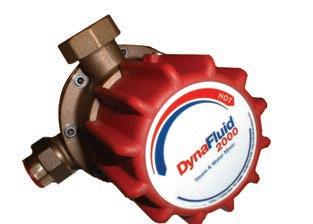













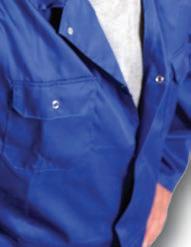


































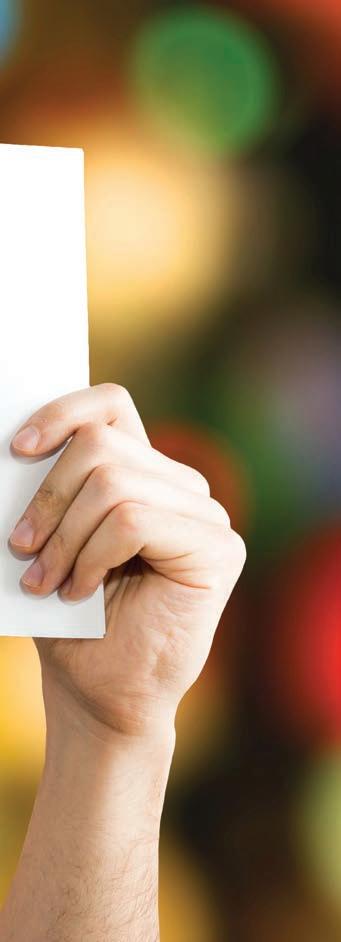

By Dave Davis, Editor
In the day-to-day operation of a drycleaning company, it can be easy to lose sight of the elements that customers might notice about the store and the service they receive. That’s why it’s vital to seek feedback from clients to make sure they are being treated properly and that, from their perspective, the business location is running well.
From gathering online reviews to hiring marketing companies to performing mystery shopping experiences, today’s cleaners have more options than ever to hear from their customers and see how their stores work from the other side of the counter.
Seeking out feedback is a priority for both David Meyer, owner of Elite Cleaners in Phoenix, Arizona, and Michael Harris, owner of Oceanside Cleaners in Jacksonville, Florida. Both businesses have hired a marketing company to oversee the feedback process, ensuring that it’s done regularly and uniformly.
“(The company) reaches out to the customer to see if they had a good experience,” Meyer says. “If so, they’ll ask for a review, and it works beautifully. So, we’re not really standing at the counter asking the person. It’s through a system of barriers we create, and then as people get through the barriers, we’ll ask for the review.”
Harris, who operates his company with his children Mark and Clare, also has a team he relies on for feedback.
“We have a board of customers, about 10 or 12, and I talk to them a couple times a year,” he says. “What I want is honest feedback from them on how things are going. How is our quality? How is our service?”
The counter staff is the first level of communication with clients, says Mark Harris.
“Your interactions at the counter are vitally important,” he says. “We also have three full-time office employees who answer the phones and are customer service staff. If a customer calls and has a concern or a question, or wants to know when

their laundry will be ready, our team will answer anything of that nature. We also use Slack a lot to communicate within the company, and the office staff monitors the general email, as well.”
Every customer interaction is an opportunity for gathering their opinions.
“When we get customers on the phone — if we’re asking them for approval on a cleaning issue, for instance, or any sort of issue they’ve had — my dad or I will ask them for feedback,” Mark Harris says. “‘What are your thoughts on this? How did you like that?’ A lot of the times, they’ll just be up front about everything.”
Every business owner likes to hear nice things about their company, but negative feedback can be just as important, if not more so, for improving operations.
“I have a 4.9 (review) average,” Meyer says. “We don’t get a lot of negative feedback, but if we do, I’m on it right away. I check emails as late as 3 in the morning. So, if it’s an issue that we can correct, we get on it immediately. We own it, whatever problem there is, and we have an expression: ‘What can I do to make it right?’ My negatives are low, but they can help me correct the problem. I’m very happy to get a review, good or bad, because it either tells me we’re doing our job right, or if we’re not, I try to find a way to correct it.”
“Me, my dad and my sister, Clare, all get the direct feedback and the reviews straight to our email,” Mark Harris says. “If there is something negative or needs to be addressed, we’ll do a quick huddle and decide who’s going to tackle it.”
“Honestly, I don’t care about the positive ones — that’s almost the expectation,” Michael Harris says. “Mark and Clare respond to everyone. I focus on the negative ones. Of our reviews, 99% are positive. But when we get a negative one, I personally tackle it myself.”
When Meyer does get a negative client review, especially if it calls into question a CSR’s performance, he makes sure to use it as a learning opportunity for himself and his staff.
“I’m very careful to analyze if the issue was foreseeable or unforeseeable,” he says. “Could the CSR have handled things differently? I would say in 99% of the cases, it’s a teaching moment. I analyze what the CSR could have done better, and we have a discussion about it.”
Of course, feedback doesn’t accomplish much if owners
don’t take it to heart and act on complaints or suggestions.
“We had a customer this week who was questioning why we couldn’t service his route more often,” Michael Harris says. “And I started thinking about it and thought, ‘Yeah, we can try that.’ So, we’re considering in January starting to go every day out to this certain market.”
Getting customers to offer feedback and suggestions requires creating an atmosphere where they know their opinions are valued.
“We want to open up communication,” Mark Harris says. “We believe in that strongly with our CSRs. You ask the customers one question about their family, their occupation, their recreation and their dreams. Not all customers — you have to feel the room and see if they want to talk — but a lot of times that’ll open up other conversations about dry cleaning and laundry, because not everybody wants to talk about it.”
Not every bit of feedback is actionable, Meyer believes. While it’s welcomed, sometimes there might not be a solution to the customer’s problem.
“We’re not afraid to ‘fire’ customers,” he says. “With a negative review, either there’s a valid point and we address it, apologize for it and make it better, or we realize that we can’t make that customer happy, no matter what — there are customers like that.”
Even if that’s the case, Meyer believes that there doesn’t need to be animosity in the discussion.
“The CSR has the ability to explain to the customer that maybe we’re not a good fit,” he says. “We haven’t done that a lot, but whenever it happens, we evaluate whether we were wrong or the customer is impossible. If they’re impossible, then we just suggest they find another cleaner.”
“One misconception we frequently see is that all customers prioritize speed and convenience above all else,” says Christopher White, executive director of America’s Best Cleaners (ABC), which offers professional consulting services. “While this is true for some, particularly those using kiosks or home delivery, our 25 years of data show that clients with high-end garments often value a personalized, detail-oriented luxury level of service far more.”
To accomplish this personalized experience, White believes that cleaners need to strike a balance between using technology to serve convenience-focused customers while ensuring premium clients receive the care they’ve come to expect.
“This care includes personalization, authentic greetings (Continued on page 19)






















































































































































(Continued from page 14)
and knowledge of textiles and fashion to provide sound guidance of service offerings,” White says. “This starts with hiring people who are naturally friendly and get pleasure out of serving others.”
One of the benefits ABC offers to members — and is part of the organization’s annual certification process — is its mystery shopping program.
“Mystery shoppers evaluate multiple dimensions of service,” White says, “including client experience, staff professionalism, garment handling, turnaround times and the overall quality of the finished product. These evaluations are not just for internal improvement; they are a key component of our annual certification process. Our affiliates are randomly secret-shopped eight times a year — twice per quarter — including at 24/7 kiosks and home pickup and delivery locations. This ensures a consistent, high level of service across all aspects of the business, from in-store interactions to the conveniencedriven elements of our affiliate businesses.”
He adds that having secret shoppers come to a business eight times a year is the minimum — some owners utilize this option many more times than that annually, welcoming the challenge as they search for ways to improve their service while looking for warning signs.
“Common red flags include inconsistent quality, late orders, a lack of communication with clients about damages or repairs, and unprofessional interactions,” White says. “We see a lot of affiliates leaving money on the counter by not offering repairs and specialty processes.
“For businesses that have integrated technology like kiosks and home delivery, a major warning sign is failing to maintain the same high level of service across these channels. Mystery shoppers help uncover these gaps so businesses can address them promptly.”
Before online reviews and other methods were available, mystery shopping was one of the few methods cleaners had to gauge how customers were seeing their business. Now, mystery shopping has become a more targeted tool.
“Online reviews are going to give us that raw feedback, but that does get emotional sometimes,” White says. “Mystery shopping lets us know the specific things that we want to execute. It could be something as simple as are the employees smiling? Are they greeting customers properly? And there are more technical aspects, such as recognizing that there’s specific damage on a garment and they are informing the customer about opportunities to solve that problem.”

Meyer says his company uses mystery shoppers because “they give you a real insight on the things you might think you’re doing right,” he says. “When you hear what a secret shopper’s findings are, you modify your behavior.”
The changes Meyer has made based on secret shopper suggestions range from simple additions to introducing customers to options they might not otherwise know about.
“Based on our secret shoppers, we now wear name tags,” Meyer says. “We also offer services to the client that they might not be aware of. Old-school dry cleaners just let you come in and go out, and they don’t offer you many of the other choices that are available — our CSRs are required to offer another service that the customer is not using.”
The natural competitive nature of dry cleaners is brought into play when it comes to ABC mystery shoppers, according to White.
“Each month, all of our affiliates receive a comparative dashboard report that shows how their business is performing relative to the entire ABC affiliation,” he says. “This allows them to track their progress and identify areas for improvement. We then use this to match those strong in one area to collaborate with those that could improve in a service skill or experience. There’s no better tool than leveraging the power of peer pressure, so we are extremely transparent.”
While both Oceanside Cleaners and Elite Cleaners use marketing companies to spearhead their feedback efforts, both say that cleaners wanting to get the view from the other side of the front counter can start simply.
“You can do it manually at the counter,” Meyer says, “and just ask the customer, ‘Did you have a good experience?’ And then, if they did, you can ask them, ‘Would you mind please putting a review on the internet for us?’ Let them decide where they’re going to do that. But if you’re not getting the reaction of a client from their point of view — not your point of view — then you’re not hitting your target correctly.”
“Be a great listener and have empathy,” Michael Harris says, noting that it’s important to keep the customer’s emotional state in mind if the feedback is negative. “Sometimes people have bad days. They’re not angry with you. It’s not personal. They just had a bad moment. Have empathy and be a good listener.”
“You’ve got to understand their side,” Mark Harris says. “Communicate to them that you understand where they’re coming from. That’s a big deal. People want to be heard. They want to be understood.”
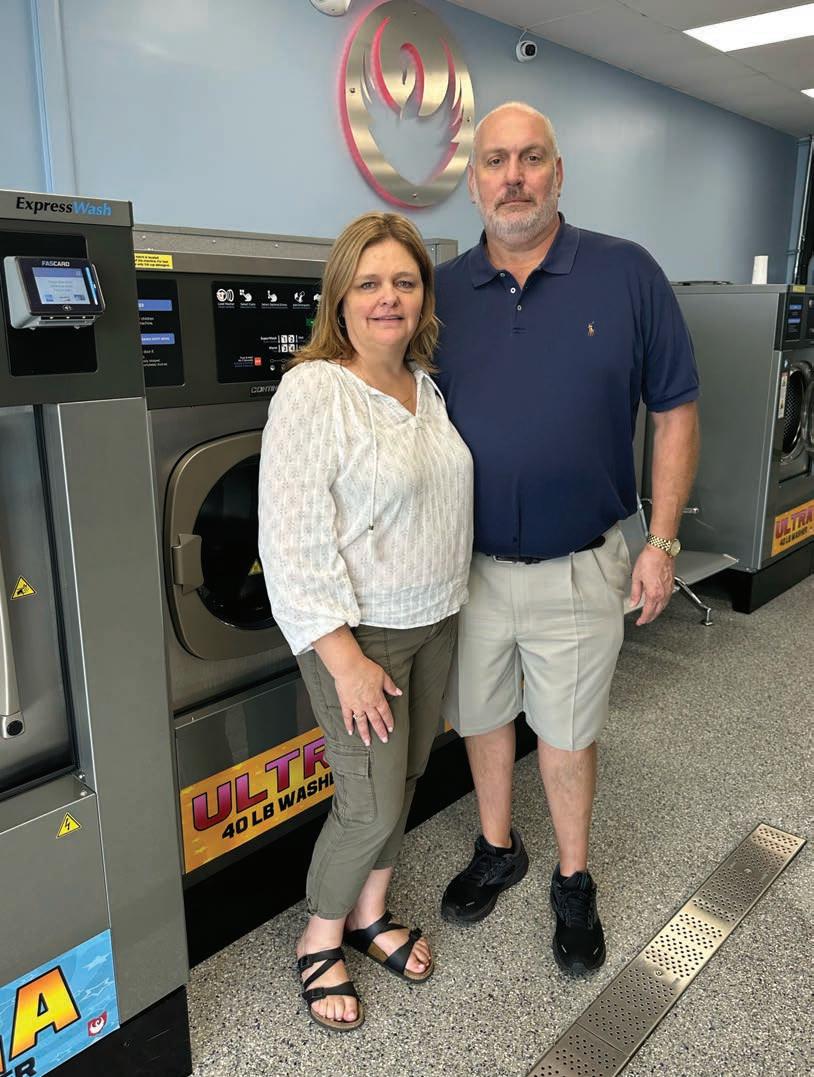


By Haley Jorgensen
TALLMADGE, Ohio — Jim Croyle and his wife, Theresa, recently opened a small, high-speed laundry next to their drycleaning plant in Tallmadge, Ohio. The new vended laundry — designed for speed, efficiency and customer convenience — is growing 18 percent month-overmonth and, after just six months, contributes 7 percent of total company revenue. At this rate, the Croyles expect a full return on investment in just five years.
Theresa and Jim Croyle, owners of White Swan Cleaners in Ohio, recently opened a small, high-speed laundry next to their drycleaning plant. At current rates, the Croyles expect a full return on investment in just five years. (Photo: Continental Girbau)












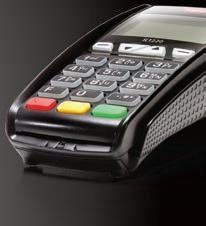








Like many dry cleaners in the industry, White Swan Cleaners is vested in history. It’s a multi-generational company purchased by Croyle’s mother in 1979, then by himself in 2008. His grandmother, grandfather and greatgrandfather all have ties to dry cleaning. Today, White Swan Cleaners includes a central drycleaning plant, two drop stores and one vended laundry. Services include dry cleaning, shirt cleaning, alterations, drop-off wash-dryfold and residential pickup and delivery.
A dip in drycleaning business spurred the Croyles’ interest in opening a vended laundry. “We had an empty spot in our retail strip mall next to the drycleaning plant,” says Croyle. “COVID hit and our drycleaning business dropped 60-70 percent. Our 1,100 dress shirts a day dropped by half. We stayed open processing clothes and medical facility goods and tried to keep as many of our employees as possible. A laundry seemed like a good solution.”
The Croyles aren’t alone. A growing number of drycleaning operators find the laundry business appealing, according to Croyle. “It can complement the business done by a dry cleaner, while offering new revenue streams with a much lower labor demand,” he says.
In the case of White Swan Laundromat, it also allowed staff to switch from the drycleaning side to the laundry side, offered high-speed equipment for self-service use and processing full-service wash-dry-fold, and helped grow pickup and delivery service. “It’s been a great crossover for us,” Croyle says.
To make their laundry idea a reality, the Croyles worked closely with Eric Vlahos of Advantage Equipment, a laundry solutions provider in Akron, Ohio. Vlahos provided pro forma financing assistance, laundry designs, equipment and more. “The Vlahos family owns and operates a laundry, so Eric understood what we needed and helped us with every aspect of the laundry’s development,” Croyle says.
The Croyles started small — walling off half of the available space for future expansion. “We built the store with the intention of growing,” Croyle says. “We can double the size overnight and go from 17 to 34 washers.”
The 1,500-square foot White Swan Laundromat is lo-
cated in a strip mall owned by the Croyles in an upscale suburban neighborhood. It features a mix of Continental Girbau high-speed washers and dryers for a quicker wash and dry; a payment system that accepts cash, debit/credit and payment apps; and a security system that automatically locks and unlocks the laundry. Amenities include free Wi-Fi, large flatscreen televisions and folding tables.
The soft-mount washers, in 20- to 80-pound capacities, are complemented by 45-pound capacity stack dryers and 75-pound capacity, single-pocket dryers. The soft-mount machines offer easy installation without bolt-down and the washers generate up to 408 G-force extract speeds for more moisture removal, quicker drying times and lower natural gas consumption.
“Fifty percent of our wash cycles are 18 minutes, and our dry cycles are 20-30 minutes,” says Croyle. “Our customers are in and out in less than an hour, which saves them two to three hours over our competition.”
Moreover, a faster wash and dry maximizes customer rotation rates, frees up popular machines and helps boost revenue. “The washers can conceivably turn three times per hour and that’s what we are hoping for,” Croyle says. “We love the soft-mount washers. I know what it’s like to run second extracts on a down comforter because it’s still wet. Our drycleaning washers only spin at 200 Gforce. The amount of money, time and energy our washers save on the drying end is amazing.”
Plus, customers can choose optional “Extras,” in addition to their standard cycles, including an “Extra Rinse,” “Extra Wash,” and “Extra Spin.” Each “Extra” vends at an additional 50 cents — padding store profit. “This absolutely offers our customers more control over how they’re laundry is washed,” says Croyle, “with 18 percent choosing an ‘Extra Wash,’ 15 percent selecting an ‘Extra Rinse’ and another 15 percent adding an ‘Extra Spin.’”
With labor shortages continuing nationwide, the demand for automated services has become commonplace and easy to implement into daily operations, according to Croyle. “In our personal laundry experience, we have automated several of the daily tasks.”
Simplifying life, the laundry’s security technology automatically opens doors at 6 a.m. and locks them at 10 p.m. At 9 p.m., it alerts customers through Amazon’s Al(Continued on page 27)
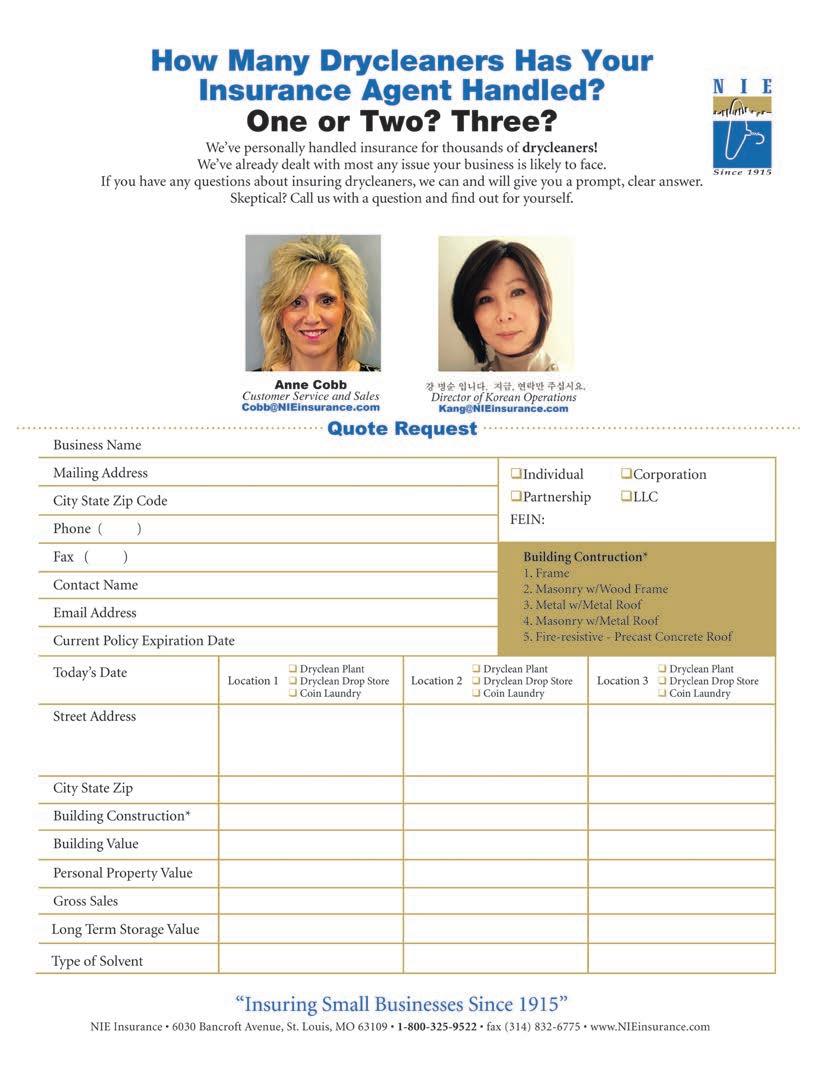
There’s more: We’re just two members of NIE’s team of experts. NIE has been handling fabricare insurance since 1915!
By Dave Davis, Editor
In an effort to combat money laundering and other financial crimes, the federal government passed legislation this year that requires most small- to mid-sized companies to document who has a hand in their operations.
This requirement, which affects almost all drycleaning company owners, is part of the Corporate Transparency Act (CTA), which went into effect on January 1. It requires most companies to file what is called a Beneficial Ownership Information, or BOI, report with a federal agency called the Financial Crimes Enforcement Network (FinCEN).
The CTA was the topic of a webinar, “Beneficial Ownership Reporting is Here: What Small Business Owners Need to Know about the New Reporting Requirements,” hosted by the National Federation of Independent Business (NFIB). In the webinar, Sandra Feldman, attorney and beneficial ownership information reporting expert with Wolters Kluwer CT Corporation, offered information about the new requirement, along with information about filing and penalties in the event of violations.

“Millions of corporations, LLCs and other similar entities are formed in the United States each year,” Feldman says, “but the states where they’re formed don’t require information about the beneficial owners.”
Beneficial owners, in this sense, are the individuals who ultimately own or control those business entities.
This lack of oversight, Feldman explains, allows who Congress refers to as “malign actors” to conceal their ownership of these entities and use them to launder money, finance terrorism, commit tax fraud and other illicit activities.
“FinCEN is a name you will become very familiar with the more involved you become over time with BOI reporting,” Feldman says.
The Financial Crimes Enforcement Network is a bureau in the U.S. Department of Treasury. In the CTA, Congress provided a basic framework of what is needed to be done to comply.
Almost every small- to mid-sized business, Feldman says, has to file with FinCEN on this matter. Businesses having to file include:
• Every corporation
• Every LLC
• Every other entity that is created by the filing of a document with the Secretary of State or similar office
“Large Operating Companies” are entities that don’t have to file a BOI report. These companies are classified as those with more than 20 full-time employees in the U.S., have more than $5 million in gross receipts or sales, and have an operating presence at a physical office in the U.S. All three of these requirements are necessary to be considered a Large Operating Company.
“All reporting companies have to provide information in their initial report about the company, and about all of their beneficial owners,” Feldman says. Reporting companies created on or after Jan. 1, 2024, also must provide information in their application to form a company.
Information about the company in a BOI report includes:
•Full legal name (as it appears in the articles of organization)
•Any trade or DBA name
•Street address of the company’s principal place of business (PPB)
•The state where the company was formed
•IRS Taxpayer Identification Number — This is either the employer identification number (EIN) or social security number (SSN) if that’s what the company utilizes.
Information necessary for all beneficial owners includes:
•Full legal name
•Date of birth
•Residential street address
•Unique ID number and its issuing jurisdiction (this




can include non-expired passports, state IDs or driver’s licenses)
The report also must include an image of the document from which the unique identifying number was obtained.
“The term ‘beneficial owner’ is defined extremely broadly,” Feldman says, “and it could include some individuals who you might not have realized were beneficial owners.”
According to the FinCEN, beneficial owners are defined as “any individual who, directly or indirectly, either exercises substantial control over a reporting company or owns or controls at least 25% of the ownership interest of a reporting company.”
“Note that an individual can be a beneficial owner, either by exercising substantial control or owning 25%,” Feldman says. “You don’t have to be both — you can be, but you don’t have to be.”
Feldman gives the example of an LLC that has five members, each owning 20%. “None of those members would be beneficial owners based on the 25% ownership criteria,” she says. “But if any of those members exercised substantial control, they are beneficial owners,




























































































































even though they don’t own 25%.”
What does it mean to exercise substantial control over a company? Feldman says FinCEN views substantial control by an individual in any one of four ways:
•They serve as a senior officer (President, CFO, GC, CEO, COO)
•They are authorized to appoint or remove senior officers or majority of board
•They direct, determine or influence important decisions, such as the sale, lease, mortgage of principal assets; reorganization, dissolution, or merger; major expenditures; selection or termination of business lines; compensation and/or incentive programs for senior officers; entering into or terminating contracts; or mending governance documents
•Any other form of substantial control
The last method, Feldman says, is the “catch-all provision, as FinCEN tries to eliminate any loopholes in the definition.”
A beneficial owner is also an individual who owns or controls at least 25% of the reporting company’s ownership interests, Feldman says, and the term ‘ownership interest’ is also defined very broadly.
“It includes any equity or stock,” she says, “which is the ownership interest you typically see in a corporation.”
When the BOI must be filed depends on when the company was created, Feldman says.
•Companies created before Jan. 1, 2024, must file with FinCEN by Jan. 1, 2025.
•Companies created in 2024 must file within 90 calendar days after receiving a notice of creation.
• Companies created in 2025 and beyond must file within 30 calendar days after receiving a notice of creation.
•Companies that were once exempt but lose that exemption for whatever reason must file within 30 calendar days of no longer qualifying.
“Congress wants this information to be current,” Feldman says, “so if there’s a change in the information that was last reported to FinCEN concerning the company or the beneficial owners, the reporting company must file an updated report within 30 calendar days after the change occurs.”
Congress not only expects the information to be up to date, but also to be accurate, Feldman says.
“If any report contained inaccurate information about the reporting company, beneficial owners or company applicant when the report was filed,” she says, “the reporting company has to file a corrected report within 30 calendar days after the date the company becomes aware of or has reason to know of the inaccuracy.”
“All BOI reports are filed electronically with FinCEN,” Feldman says. “There is no state filing. You only file with FinCEN. There is no fee, and the report can be filed by anyone the reporting company authorizes to act on its behalf.”
For those who file on their own behalf, Feldman says they can go to the BOI e-filing portal, located on the FinCEN website (https://www.fincen.gov). “When you go to the portal,” she says, “you will see a couple of options. You can download a PDF, fill it out and then upload it and submit it to FinCEN, or you can use their web-based version, fill the report out online and then submit it.”
There is also the option of using a third-party service provider, who will take the information and submit it on the company’s behalf. While these providers will charge a fee, potential advantages to this, Feldman says, include simplified data collection and confidence in the filing.
So, what are the penalties for violating this new requirement, and what are considered violations?
“Violations include willfully failing to file a complete initial, updated or corrected BOI report,” Feldman says, “and willfully filing or attempting to file false or fraudulent beneficial ownership information.”
Potential penalties include a civil penalty of up to $500 for each day the violation continues. Criminal penalties include up to two years imprisonment and a fine of up to $10,000.
For more information, Feldman suggests the CTA/BOI reporting resources page at https://www.fincen.gov/boi. “They have a lot of good resources, including a small entity business guide, FAQs and videos,” she says.







(Continued from page 22)
exa system of the last wash. Simultaneously, lights illuminate and turn off automatically. Every half hour, team members from the drycleaning plant walk over and tend the laundry or use idle washers to process wash-dry-fold.
Meanwhile, the laundry’s payment system offers simple machine operation for customers and provides sophisticated store management. Using this system, the Croyles can run promotions, access customer information, issue refunds and analyze machine operation, store performance and revenue.
Finally, the laundry also harnesses the drycleaning plant’s SMRT point-of-sale system to track wash-dryfold poundage, text updates to customers and send pickup and delivery reminders. When customers don’t have a pickup, the software automatically drops them from the manifest, which in turn reduces vehicle wear and tear, labor hours and fuel.
At the end of the day, the drycleaning side complements the laundry side and vice versa — allowing for
more efficient use of labor, equipment, technology, delivery routes and marketing. Working together, the businesses share resources while creating a bigger customer pool and diversification of services.
“The addition of the laundry, especially directly next door to our main plant, has led to many crossover customers,” Croyle says. “Our drycleaning customers have learned of our wash-dry-fold services and are adding it to the services they already use. Similarly, our laundry customers coming to the dry cleaner with their finer clothes to be professionally cleaned and pressed are learning of our other services, including alterations and household item cleaning.”
Ultimately, the Croyles plan to expand their laundry footprint, first by doubling the size of the current laundry. They’ll do this by removing the “Phase 1” wall and adding equipment. Thereafter, they hope to develop laundries in neighboring communities that need “good, clean laundries,” says Croyle.










West and East events consolidated value for audiences and exhibitors
LAS VEGAS — The Drycleaning and Laundry (DL) Expo West, held Oct. 4-6 in Las Vegas, brought out drycleaning company owners and operators, equipment manufacturers, industry experts and others. The event, which drew about 1,200 attendees, topped organizers’ expectations, ensuring it will continue in the future.
DL Expo West — along with its sister show, DL Expo East, held in Kissimmee, Florida in June — was created by the California Cleaners Association (CCA), the Southwest Drycleaners Association (SDA), the South Eastern Fabricare Association (SEFA) and the Pennsylvania Delaware Cleaners Association (PDCA). The organizations came together to co-brand and organize the shows, which took the place of separate smaller regional shows.
By bringing together groups for these two shows, rather than several regional shows, organizers believe that a “critical mass” of attendees and exhibitors could be achieved, making the event more valuable and worthwhile for all concerned.
“DL Expo West was an unqualified success,” says CCA President Toran Brown. “It exceeded everybody’s expectations, and went well beyond the expected number of attendees and exhibitors.”
“We were very encouraged and gratified by the attendance numbers at the DL Expo West,” says SDA Expo Committee Chair and Director Jess Culpepper. “There was an array of top-tier vendors, speakers and educational sessions to offer beneficial information and content to all who were in attendance.”
“We had outstanding attendance and feedback from attendees and exhibitors,” says Allan Cripe, a member of the SDA Expo Committee and an SDA director. “Were there any surprises? There are always little issues that crop up in these shows, most of them logistical. However, overall, I feel like the show was executed by our management team to perfection.”
One of the surprises, organizers say, was the attitude of attendees.
“The industry has had a head wind of issues in recent years, so witnessing the excitement, energy and overall
positive outlook from those in attendance and the vendors was an uplifting experience,” Culpepper says.
“People have been more down in the dumps previously because of COVID, but in this show and in the DL Expo East show, there’s been more of a feeling of, ‘OK, we’ve got opportunities in front of us.’ There are still challenges ahead, of course, but there’s a sense that there’s a path forward. It was refreshing.”
The DL Expos were designed to take economic realities into account and bring dry cleaners and exhibitors together.
For years, the joint state associations (JSAs) were having equipment shows and tabletop shows and educational sessions, Brown says. “The allied trades for our industry have gone above and beyond in their support. They either sent people to the shows, or sent equipment or sponsored them. It’s a symbiotic relationship.”
Over the years, however, the old model became more difficult to sustain. “They have to spend a lot of money to exhibit at these shows in the manner we are accustomed to seeing,” Cripe says.
“As the industry has changed,” Brown says, “and particularly during COVID, it became clear that it was becoming increasingly difficult to be able to continue to provide that financial support and still be in a position to hold their pricing down so that people can afford to buy their product.”
“The main objectives of combining the regional shows,” Culpepper says, “were to decrease the burden placed on our vendors of the expense of traveling and exhibiting at four to five different shows in one year, and to boost the number of attendees that attend the regional shows. I would say without question our first go out of the gate we succeeded at those ambitions.”
“We’re going to go through a debrief meeting in the next couple days,” Brown says, “and I know there are some things that we’re going to want to fine tune before we do another one. But having said that, I would say that, as a whole, both shows went off better than anybody expected, both for vendors and attendees.”
The concept of the DL Expo shows was to run during off-Clean-Show years, and their success means new offerings in 2026.
“For DL Expo West we will be in Irving, Texas in 2026 and it will once again be a collaboration between SDA and CCA,” says Cripe. “I can’t yet speak for the DL Expo East with certainty, but all indications are
that they will also be having their show in 2026. Based on the results and feedback from the shows this year, it looks to be a solid model going forward and we are happy and blessed to be a part of it.”
“I’m a third-generation dry cleaner. I don’t do things the way my grandfather did,” Brown says. “It’s a different industry, they’re different players and it’s a different customer. We all have to be not only open to change, but we need to be looking for those changes and making those changes happen so that, as an industry, we can be the best we can be.”
Union Dry Cleaning president passes away at 56
PEACHTREE CITY, Ga. — Jack Burnett Jr., president of Union Dry Cleaning Products, died peacefully at home on October 5 after a year-long battle with cancer. He was 56.

Burnett started at Union in 1990 as one of its first hires, says Vic Williams, who will be stepping into Burnett’s role as president of the company.
“It’s huge what he did for the company,” Williams says. “Much of the company’s success comes from the team he built here. He was a fair man, loyal and giving to his employees. He didn’t just look out for himself — he looked out for the entire team at Union.”
Williams, who worked with Burnett for 32 years, says that his leadership style gave Union a “family” feel.
“People don’t really leave our company,” he says. “Jack is a big reason as to why we’ve had very little turnover through the years. One of the things I learned from him was how to treat people — your team, your distributors and everyone else you work with. He was also a great dad, and I learned a lot about being a father from him, as well.”
When not at work, Burnett was passionate about travel and all things Disney, but most of all spending time with his family.
Burnett is survived by his wife Kristin; his sister Lisa Jurchenko (Andrew Jurchenko); his three daughters: Emma Burnett Webb (Chris Webb), Claire Burnett Wilson (Max Wilson) and Alyce Burnett Head (Wesley Head); and his granddaughter, Eleanor (“Ellie”) Webb.
In lieu of flowers, the family requests donations be made to the Cholangiocarcinoma Foundation.






































2024 RATES: One- to five-time rate: $2.35 per word, boldface $2.40 per word. Minimum charge: $50.00 per ad. Call or write for our threeand 11-time rates. If box number is

used, add cost of 5 words. Display classified rates are available on request. All major credit cards are accepted.
DEADLINE: Ads must be received by the 1st of the preceding month. For example, for a August ad, the closing date is July 1st.
PAYMENT FOR CLASSIFIED ADS: Must accompany order.








• Business Exit Strategy
• Merger, Sale or Acquistion
• Business Fair Market Value
• Succession or Partnership Issues
• Financing or Environmental
• Business Strategic Thinking
Contact us for a compimentary chat: Richard Ehrenreich, CED, SBA, F-CBI Ehrenreich & Associates, LLC 301-924-9247 • Richard@EhrenAssoc.com



















MANAGEMENT, AND CIRCULATION 1. Publication Title: AMERICAN DRYCLEANER 2. Publication Number: 0002-8258 3. Filing Date: 9/18/24. 4. Issue Frequency: Monthly 5. Number of Issues Published Annually: 11 6. Annual Subscription Price: $50.00. 7. Complete Mailing Address of Known Office of Publication: American Trade Magazines LLC, 650 West Lake St., Suite 320, Chicago, IL 60661-1036 Cook County. Contact Person: Charles Thompson, 312-361-1680. 8. Complete Mailing Address of Headquarters or General Business Office of Publisher: American Trade Magazines LLC, 650 West Lake St., Suite 320, Chicago, IL 606611036 Cook County. 9. Full Names and Complete Mailing Addresses of Publisher, Editor, and Managing Editor. Publisher: Charles Thompson, American Trade Magazines LLC, 650 West Lake St., Suite 320, Chicago, IL 60661-1036 Cook County. Editor: Dave Davis, American Trade Magazines LLC, 650 West Lake St., Suite 320, Chicago, IL 60661-1036 Cook County. Managing Editor: Bruce Beggs, American Trade Magazines LLC, 650 West Lake St., Suite 320, Chicago, IL 60661-1036 Cook County. 10. Owner: American Trade Magazines LLC, 650 West Lake St., Suite 320, Chicago, IL 60661-1036 Cook County. Charles Thompson, American Trade Magazines LLC, 650 West Lake St., Suite 320, Chicago, IL 60661-1036 Cook County. Donald Feinstein, American Trade Magazines LLC, 650 West Lake St., Suite 320, Chicago, IL 60661-1036 Cook County. Bruce Beggs, American Trade Magazines LLC, 650 West Lake St., Suite 320, Chicago, IL 60661-1036 Cook County. Nathan Frerichs, American Trade Magazines LLC, 650 West Lake St., Suite 320, Chicago, IL 60661-1036 Cook County. John S Suhler, 200 Long Neck Point Rd., Darien, CT 06820 Fairfield County. 13. Publication Title: AMERICAN DRYCLEANER 14. Issue Date for Circulation Data Below: September

2024 15. Extent and Nature of circulation: (average number of copies each issue during proceeding 12 months = “X”) (Number copies of single issue published nearest to filing date = “Y”) (a)Total Number of Copies (Net press run): X=9760, Y=9732. b. Legitimate Paid and/ or Requested Distribution (By Mail and Outside the Mail). (1) Outside County Paid/Requested Mail Subscriptions stated on PS Form 3541. (Include direct written request from recipient, telemarketing and Internet requests from recipient, paid subscriptions including nominal rate subscriptions, employer requests, advertiser’s proof copies, and exchange copies.) X=5833, Y=6003. (2) In-County Paid/Requested Mail Subscriptions stated on PS Form 3541. (Include direct written request from recipient, telemarketing and Internet requests from recipient, paid subscriptions including nominal rate subscriptions, employer requests, advertiser’s proof copies, and exchange copies.) X=0, Y=0. (3) Sales Through Dealers and Carriers, Street Vendors, Counter Sales, and Other Paid or Requested Distribution Outside USPS®: X=0, Y=0. (4) Requested Copies Distributed by Other Mail Classes Through the USPS (e.g. First-Class Mail®): X=0, Y=0. (c) Total Paid and/or Requested Circulation (Sum of 15b (1), (2), (3), and (4)): X=5833, Y=6003. (d) Nonrequested Distribution (By Mail and Outside the Mail). (1)Outside County Nonrequested Copies Stated on PS Form 3541 (include Sample copies, Requests Over 3 years old, Requests induced by a Premium, Bulk Sales and Requests including Association Requests, Names obtained from Business Directories, Lists, and other sources): X=3613, Y=3432. (2) In-County Nonrequested Copies Stated on PS Form 3541 (include Sample copies, Requests Over 3 years old, Requests induced by a Premium, Bulk Sales and Requests including Association Requests, Names obtained from Business Directories, Lists, and other sources): X=0, Y=0.
(3) Nonrequested Copies Distributed Through the USPS by Other Classes of Mail (e.g. First-Class Mail, Nonrequestor Copies mailed in excess of 10% Limit mailed at Standard Mail® or Package Services Rates): X=0, Y=0. (4) Nonrequested Copies Distributed Outside the Mail (Include Pickup Stands, Trade Shows, Showrooms and Other Sources): X=0, Y=0. (e) Total Nonrequested Distribution (Sum of 15d (1), (2), (3) and (4)): X=3613, Y=3432. (f) Total Distribution (Sum of 15c and e): X=9446, Y=9435. (g) Copies not Distributed (See Instructions to Publishers #4, (page #3)): X=314, Y=297. (h) Total (Sum of 15f and g): X=9760, Y=9732. (i) Percent Paid and/or Requested Circulation (15c divided by f times 100): X=61.75%, Y=63.62%. 16. Electronic Copy Circulation: (a) Requested and Paid Electronic Copies: X=333, Y=258 (b) Total Requested and Paid Print Copies (Line 15c) + Requested/Paid Electronic Copies (Line 16a): X=6166, Y=6261. (c) Total Requested Copy Distribution (Line 15f) + Requested/Paid Electronic Copies (Line 16a): X=9779, Y=9693. (d) Percent Paid and/ or Requested Circulation (Both Print & Electronic Copies) (16b divided by 16c x 100): X=63.06%, Y=64.59%. I certify that 50% of all my distributed copies (electronic and print) are legitimate requests or paid copies. 17. Publication of Statement of Ownership for a Requester Publication is required and will be printed in the November/December 2024 issue of this publication. 18. Signature and Title of Editor, Publisher, Business Manager, or Owner: I certify that all information furnished on this form is true and complete. I understand that anyone who furnishes false or misleading information on this form or who omits material or information requested on the form may be subject to criminal sanctions (including fines and imprisonment) and/or civil sanctions (including civil penalties): Charles Thompson, Publisher, Date 9/18/2024.
10 YEARS AGO. To Perc or Not to Perc? — According to the American Drycleaner Your Views survey, in the light of the regulatory environment, roughly 69% of dry cleaners believed that perchloroethylene — perc — would no longer be a viable solvent option for the average operator within 10 years. Of that group, 35.6% believed perc had another five years, while 32.9% gave it another 10 years. Approximately 15% said perc would remain a viable drycleaning solvent operation “indefinitely,” with another 12% giving it another 15 years, and 4.1% giving it 20 years. “Dry cleaners need to be flexible,” one respondent said. “As perc is phased out, we need to understand that the customer still expects clean, spot-free cleaning.”
25 YEARS AGO. New Bill Adopts
Barton Language — The Small Business Remediation Act, also known as the Barton Bill, drew more cosponsors from the ranks of the House of Representatives, bringing the total to 42, not including original sponsor, Rep. Joe Barton (R-Texas). In a related development, much of the Barton Bill’s language was attached in October 1999 to a larger Superfund bill, H.R. 2580. The bill was marked up and passed 25-20 in a full session of the House Commerce Committee following a debate on the definition of drinking water. The next step for H.R. 2580 would be to go to the House Committee on Transportation and Infra-




structure’s subcommittee on Water Resources and Environment, where it could ultimately be combined with H.R. 1300, a Superfund reform bill.
The North Carolina Association of Launderers & Cleaners published a folder titled “Is My Drycleaner Doing a Good Job?” The folder was designed to educate consumers on what good dry cleaning looks like, and to rate their own cleaner. The check list included topics such as clean clothes and lint-free pockets, straight hemlines and pleats, colors that are bright and true, spots and stains removed and more. One major thing to look for, it was advised, was a cleaner who gives personal, individual attention to the customer and their clothes. Many clothes-
conscious customers, the folder said, regard their drycleaner as their “clothes doctor” and consult them often for advice and help.
ing — Although World War II was in its earliest stages and the United States had yet to wade into the conflict, the British sense of humor was alive and well. American Drycleaner reported a London cleaner had placed a big sign in his window. At the top of the sign, he pasted huge portraits of Hitler, Von Ribbentrop, Goebbels and Himmler. Below the portraits in foot-high letters was this message: “THE ONLY THINGS WE CANNOT CLEAN BUT, THEY WILL DYE.”
— Compiled by Dave Davis, Editor



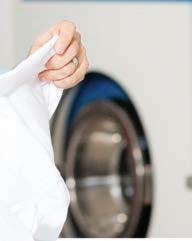


THE CLOTHES AND IMPRESS YOUR CUSTOMERS.
When you welcome American Express® Cards, you have access to benefits, services and programs to help you business thrive, including curated o ers and discounts to help you get more out of your business, and solutions & tips to help attract new customers.

Scan the QR code for more information on available resources.






